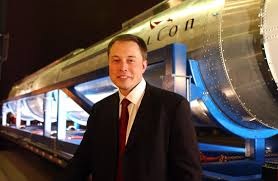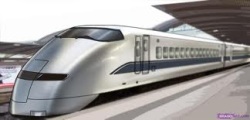
Hyperloop is the name given to a proposed rapid transit system that would connect downtown Los Angeles with San Francisco, 380 miles away. The brainchild of Elon Musk, the CEO of electric vehicle manufacturer Tesla, what distinguishes this train system is that the trip would take only 30 minutes. Last year, Musk claimed that his imagined train system would go “three or four times faster than the bullet train,” high-speed railways that can travel 200 mph and more. The hyperloop would move twice the speed of an aircraft, shuttling people from LA to San Francisco in under 30 minutes.

Tesla CEO Elon Musk has an idea for a train that would travel in excess of 600 mph.

Hyperloop would travel three or four times faster than a bullet train. It would be a cross between a Concorde, a rail gun, and an air hockey table.
The hyperloop would be “a cross between a Concorde, a rail gun, and an air-hockey table,” Musk said. He spoke at the All Things D’s 2013 conference held May 28 to 30, 2013, in Rancho Palos Verdes, California. He told the crowd that more details for the project would be available on June 20. In the spirit of this column, which is all about definitions, it will be worthwhile to break down Musk’s description of his hyperloop. First, the word itself: “Hyper” comes from the Greek “huper” meaning “over, beyond.” And “loop” is a circle, a word used to describe an electrical circuit and many other circular formations; in Chicago, the elevated railroad tracks and, by extension, the business district itself, carry that name.
More interesting perhaps are the comparisons Musk made. Perhaps we should all pay attention to science fiction, because yesterday’s fiction becomes today’s reality. Travel through the years has gotten faster and faster.
The Concorde was a supersonic passenger airline that was developed in 1969 and was in commercial operation from 1976 to 2003. Capable of flying more than 1,300 miles an hour, it flew regular transatlantic flights from London Heathrow and Paris-Charles de Gaulle Airport to New York JFK and Washington Dulles.
A rail gun is an electrically powered electromagnetic projectile launcher based on similar principles to the homopolar motor, a motor whose electromagnetic force is continuous in one direction. A railgun comprises a pair of parallel conducting rails, along which a sliding armature is accelerated by the electromagnetic effects of a current that flows down one rail, into the armature and then back along the other rail.
An air-hockey table has a fan below the surface blowing air into the table. If you look at the top of the table, there are lots of small holes, the air comes up through them beneath the puck, and the puck floats on the cushion of air below it (similar principle to the hovercraft).
Ah, the hovercraft. That’s a piece of science fiction popularized by the movie Back to the Future II , when Marty McFly travels to the year 2015 (now only two years away). Such high-speed travel was also depicted in the 1962 cartoon series The Jetsons . Hovercraft are also actually in operation. A hovercraft , also known as an air-cushion vehicle or ACV, is spoken of very much in the present tense: a craft capable of travelling over land, water, mud or ice and other surfaces both at speed and when stationary. Hovercraft are hybrid vessels operated by a pilot as an aircraft rather than a captain as a marine vessel.
Derived from a British invention in the 1950s to 1960s, hovercraft are now used throughout the world as specialized transports in disaster relief, military, and survey applications as well as for sport or passenger service. Very large versions have been used to transport hundreds of people and vehicles across the English Channel. The military uses them to transport tanks, soldiers, and large equipment in hostile environments and terrain.
Back to the near future, Elon Musk even holds out the possibility that the Hyperloop could be self-powering. “If you put solar panels on it, you generate more power than you would consume in the system. There's a way to store the power so it would run 24/7 without using batteries,” he said.
Advertisement
Learn more about Electronic Products Magazine





